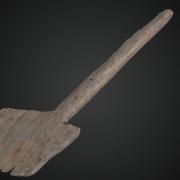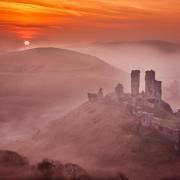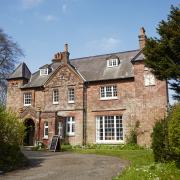The Isle of Portland is a tough place. Famous for its prisons and stone. A tear-shaped rock jutting four miles out into the English Channel, the sea around the Bill froths and chops in an aggressive tidal race that has been the ship-splintering peril of seafarers for centuries. You’ve got to be tough to be from Portland.
Which explains a lot about their sheep.
About the size of a beagle, the Portland breed is pocket-sized compared with their buxom cousins the Poll Dorset. But this ancient lineage of island sheep, well suited to the rugged, windswept environment, has helped it to become the woolly ‘Peaky Blinder’ of the sheep world.


I’m not in Portland (I’m not that tough). Before me is a photogenic Hardy-esque West Dorset farm, set in the Dorset Area of Outstanding Natural Beauty. Lower Brimley Coombe Farm is a 60-acre small holding. Jo Stover, who lives here with her husband, son, daughter, and her daughter’s new family, is probably the coolest grandmother I’ve ever met. She has a flock of 40 rare breed Portland sheep, most of which are currently peacefully grazing with their April born lambs on Waddon Hill which offers fabulous vistas over the countryside if these sheep choose to take in the view as they graze.
‘They’re incredibly easy to manage,’ professes Jo, shaking a bucket of sheep treats to tempt them over to us, ‘unlike many sheep breeds they’re adapted to lamb outside in any conditions, and they are very thrifty in what they eat.’
Jo and her husband, Dan, have trotted around the globe, their careers taking them from the ice caps of Alaska to the rugged highlands of Scotland, settling finally in Stoke Abbot. ‘Only after I’d transported my herd of Highland Cattle down south could I start to settle,’ Jo admits.

In her online blog at lowerbrimleycoombefarm.com she describes herself as an ‘American wreaking havoc on a small farm in West Dorset’. Originally from Surf City, New Jersey, Jo speaks with a terrific East Coast twang. ‘My son Archie thinks I’m bonkers for keeping Portlands,’ she quips. Archie, a graduate of the Royal Agricultural University (formerly the Royal Agricultural College at Cirencester), sensibly keeps his own commercial flock of Poll Dorset sheep. ‘He says my Portlands are useless!’
Archie is not alone in his thinking. Because of their size. Portland’s are not great meat yielders their lambs are too small. ‘They aren’t good to go to meat for at least 18 months,’ Jo adds. ‘And more time on the farm means less money.’ And for your dyed-in-the-wool commercial sheep farmer, Portlands lamb in singles not multiples.
Despite being one of Britain’s oldest breeds, their origins are pre-Roman, it’s their lack of commercial viability that brought them to the brink of extinction in the 1970s. This Dorset sheep was precariously grazing between Portland’s much sought after rock and a hard place.

Portland stone, the iconic off-white limestone hewn from the island’s quarries, is found in famous buildings all over the world, including St Paul’s Cathedral and Buckingham Palace in London, and the United Nations HQ in New York.
Used since Roman times, it was after the Great Fire of London in 1666 that the newspapers proclaimed: ‘God has provided these pure white stones to help restore Britain's greatness.’ Nearly 300 years later, it was Portland stone that city planners desired when rebuilding the battered capital after the Blitz.
The Isle of Portland’s booming stone industry led to the decline of its farming. Almost unrestricted planning permission allowed new quarries to flourish, resulting in the loss of grazing land.

Portland sheep, once crucial to early settlers (who would burn their dried dung for fuel) and even documented in the Domesday Book, 900 sheep on the Isle of Portland, faced an uncertain future. By 1920, the last Portland sheep had left the island. National stocks dwindled to a mere 79 breeding Portland ewes by 1973.
So, thank goodness for the Portland Sheep Breeders Group (portlandsheep.com) who are determined to save this rare breed. Established in 1993, the group now boasts around 140 members, including Jo, all of whom have played a pivotal role in bringing the Portland sheep back from the brink which, due to their smaller size and easy lambing, are a popular rare breed for smallholders. Today, there are almost 1500 breeding ewes spread across the UK.
When I visit Jo in early June her flock had recently lambed. Cute as they come, these handbag sized lambs are born a distinct foxy red that gradually lightens in colour over time. ‘They make exceptionally attentive mothers,’ says Jo proudly. ‘So much so they even look after some of Archie’s outcast Poll lambs!’


Both ewes and rams have the most incredible curled horns, like the ammonite fossils found along Dorset’s Jurassic Coast. Shepherds would often fashion Portland horns into crooks.
Jo also spins the wool from her flock on a loom set up in her front room. ‘Portland fleeces are creamy and soft, very desirable for hand spinners, it’s an amazing fibre to work with,’ she tells me. ‘Weavers just love it, and it is incredibly durable.’
The fleeces are sent to the Natural Fibre Company in Cornwall to be processed and spun into yarn suitable for weaving. ‘Some cones are the natural creamy colour, and some are dyed in beautiful colours reflecting the Dorset landscape. I recently made a small blanket from Portland wool for my grandson’s christening in St Mary’s Church, Stoke Abbot.’

When not tending to her beloved flock or weaving with their wool, Jo’s time is dedicated to managing the farm’s popular holiday cottages, which she and Dan created from the old milking barn. Cosy throws and bed runners, bearing the Handwoven by Shepherdess Jo label featuring the curly horned head of a Portland, ensure that guests can snuggle under a little piece of Dorset history.
‘We’re even having our own tweed made,’ Jo tells me. ‘Before long you’ll be able to wear a unique pattern of tweed, made with wool from our Portlands!’
Traditionally a Portland shepherd would put their tups (rams) to their ewes on Bonfire Night, to ensure that lambing would take place over April. As we move into autumn, Jo’s Portlands from last spring will now go to meat as hogget. This is the stage where a sheep has spent between one and two years on pasture. As a result, they develop more flavour and have a better meat to fat ratio. ‘It’s a very delicate meat,’ Jo explains. ‘It’s got a deep flavour, without being too strong and greasy like sheep can sometimes be.’


Jo’s Portland hogget is the choice pick at the Brace of Butchers in Poundbury, and it received rave reviews from Dorset-based chef and food writer Mark Hix in his food column in The Telegraph. Keeping her operation local, Jo also supplies hogget to Nick Tett’s in Beaminster and you’ll often find it on the menu of the village local, The New Inn.
‘I also sell lambs and shearling ewes every year. I don't want my flock to get too big and there are new breeders and other breeders wanting to bring in different genetic lines, so we all do our bit.’
Regularly showing her Lewesdon Hill Flock at the Melplash Show to great acclaim, this doughty American has worked incredibly hard to spread the word about Portlands. From hogget to home woven blankets and Portland tweed, Jo is a devoted cheerleader for this plucky Dorset native. She even commissioned Flora Jamieson, a stained-glass artist in Bridport, to create a stunning window for one of the holiday cottages featuring ‘a very handsome and regal Portland ram’. This is how much this woman adores her sheep.
On a tablet of Portland stone, above the entrance of St Paul’s Cathedral, inscribed in Latin is the word ‘RESURGAM’ (I will rise again). It acts as a metaphor for the rebuilding of London after the Great Fire. But in this instance, it could also be a motto for these tough little sheep that have happily roamed the windswept cliffs of the Isle of Portland for centuries. And now have their very own fan club.
Find out more at lowerbrimleycoombefarm.com



























